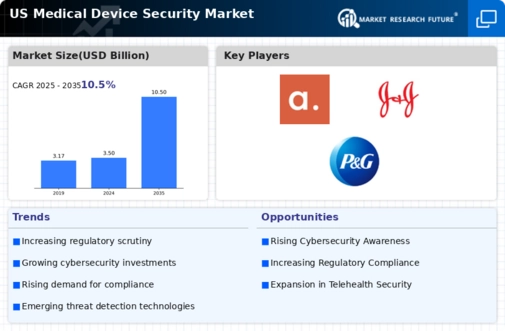The medical device-security market is currently characterized by a dynamic competitive landscape, driven by the increasing need for robust cybersecurity measures in healthcare settings. Key players such as Medtronic (US), Johnson & Johnson (US), and GE Healthcare (US) are actively positioning themselves through innovation and strategic partnerships. Medtronic (US) has focused on enhancing its cybersecurity protocols across its device portfolio, indicating a commitment to safeguarding patient data and maintaining regulatory compliance. Meanwhile, Johnson & Johnson (US) has been investing in digital transformation initiatives, aiming to integrate advanced security features into its medical devices, thereby enhancing their appeal in a market that increasingly prioritizes security. GE Healthcare (US) is also making strides by collaborating with cybersecurity firms to bolster its device security, reflecting a trend where partnerships are becoming essential for competitive advantage.
In terms of business tactics, companies are increasingly localizing manufacturing and optimizing supply chains to enhance responsiveness to market demands. The competitive structure of the market appears moderately fragmented, with several players vying for market share. However, the influence of major companies like Medtronic (US) and Johnson & Johnson (US) is substantial, as their strategic initiatives often set industry standards and drive innovation.
In October 2025, Medtronic (US) announced a partnership with a leading cybersecurity firm to develop next-generation security solutions for its medical devices. This collaboration is likely to enhance the security features of its devices, addressing growing concerns over cyber threats in healthcare. The strategic importance of this move lies in Medtronic's proactive approach to cybersecurity, which may not only protect its devices but also strengthen its market position by building trust with healthcare providers and patients alike.
In September 2025, Johnson & Johnson (US) launched a new line of smart surgical instruments equipped with advanced security protocols. This initiative underscores the company's commitment to integrating security into the design phase of its products, potentially setting a new benchmark for device security in surgical settings. By prioritizing security from the outset, Johnson & Johnson (US) may enhance its competitive edge and appeal to hospitals increasingly concerned about cybersecurity risks.
In August 2025, GE Healthcare (US) unveiled a comprehensive cybersecurity framework aimed at protecting its imaging devices from potential cyber threats. This framework not only enhances the security of its products but also positions GE Healthcare (US) as a leader in the proactive management of cybersecurity risks in medical devices. The strategic significance of this framework lies in its potential to reassure healthcare providers about the safety of their investments in GE's technology, thereby fostering long-term customer loyalty.
As of November 2025, the competitive trends in the medical device-security market are increasingly defined by digitalization, sustainability, and the integration of artificial intelligence (AI). Strategic alliances are shaping the landscape, as companies recognize the need for collaborative efforts to address complex cybersecurity challenges. Looking ahead, competitive differentiation is likely to evolve, with a shift from price-based competition to a focus on innovation, technology, and supply chain reliability. This transition suggests that companies that prioritize advanced security features and robust supply chains may gain a significant advantage in the marketplace.














Leave a Comment